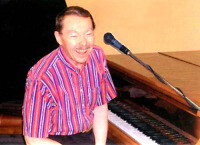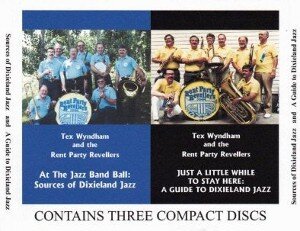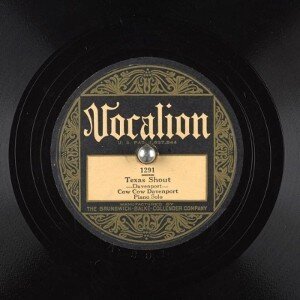 Set forth below is the seventy-third “Texas Shout” column. It first appeared in the June 1996 issue of The American Rag. The note below was added when the column was reprinted in July 2004.
Set forth below is the seventy-third “Texas Shout” column. It first appeared in the June 1996 issue of The American Rag. The note below was added when the column was reprinted in July 2004.
Although the text has not been updated, I want to add some additional comments both here and at the conclusion of the essay because, as can now be seen in hindsight, this one has proved to be the most important “Texas Shout” to today’s Dixieland fans. It tells you where you will be able to locate the music here in the 21st century. You will need to seek out your local Functional (as defined below) Dixielanders and go where they’re playing – but it won’t usually be at the places where you’ve hitherto been accustomed to finding our music.
You and I believe that Dixieland jazz is an art music and belongs to the ages. Unfortunately, but not surprisingly, it has turned out that Dixieland, like all other vernacular music that has come along since the dawn of history, is music of its time.
That time was the first half of the 20th century. The number of people born after 1939 who have become seriously interested in Dixieland jazz is insignificant and is going to remain so. The music of the second half of the twentieth century is heavy metal rock, which has a musical vocabulary and musical conventions so different from those of Dixieland that people brought up on heavy metal rock find it very difficult, if not impossible, to relate to our music.
There has been much written, some of it in “Texas Shout”, about various “revivals” of Dixieland jazz: the forties in New Orleans and San Francisco; the flurry in the fifties when all-Dixieland LPs were finding an enthusiastic market; and the wave of Dixieland societies and festivals that started springing up in the sixties.
However, it can now be seen that none were revivals in the only meaningful sense of the word – that is, none attracted a substantial number of new fans. Instead they merely reshuffled the already existing, but slowly diminishing, group of devotees who grew up with at least some Dixieland around them on a regular basis. Specifically, none attracted many listeners born after 1939.
The number of folks alive in 1940 who are still ambulatory has been steadily decreasing and is going to go to zero. When, in the sixties, their numbers became too small to sustain every-evening night spots with house Dixieland combos, they morphed into fans who attended annual all-Dixieland weekends around the country or monthly Dixieland concerts at local jazz societies. Now there are so few of them that most Dixieland societies are grasping at straws to stay above water and all-Dixieland weekends, though a handful seem to be getting by for now, are inexorably fading into the sunset.
For example: A recent newsletter of the San Diego Dixieland society says that attendance at its regular functions needs to TRIPLE (will never happen) in order to retain the site and that attendance at its host hotel needs to increase to retain that locale for its annual festival. The former all-Dixieland Santa Rosa/Sonoma County festival has changed its name and intends to broaden the type of music offered, following the footsteps, chronicled over the years in these pages, of many other festivals. Anna’s Party West and the June 2003 San Diego Jazz Break – despite top-drawer lineups, reasonable prices, accessible locations in highly populated areas, and wide publicity in the Dixieland community – drew so poorly that they, along with several other Dixieland weekends in the same circumstances, will not be repeated. The two Dixieland societies nearest my home are both sustained in large part by angels who, to their credit, subsidize concert losses in order to maintain live Dixieland near their domiciles. The Membership Secretary of Washington D.C.’s Potomac River Jazz Club reported last January that renewals to that date were off by 40%. The list is endless, as regular TAR readers are well aware.
This gloomy, but accurate, summary provides a current context for the following discussion of Art Form and Functional Dixieland. I’ll be back with some additional thoughts after you’ve read the original column.
The American Rag, its readers, writers and publishers, are part of a Dixieland community strongly interested in the promotion and preservation of our music as an art form. For the balance of this column, I will refer to that community as Art Formers. It consists of, among others, musicians, fans, record producers, publishers, record collectors, writers, jazz society officials and festival promoters.
There is another Dixieland community existing alongside, but almost invisible to, the Art Formers. It was touched upon in Dan Zeilinger’s excellent column in the October 1995 issue. I thought you might be interested in knowing a bit more about the structure of this second body of Dixielanders and how it works.
These folks depend on the fact that Dixieland jazz still satisfies the need that called it into being in the first place – providing infectious upbeat background for good times at picnics, advertising affairs, dances and other social and commercial functions. I will refer to them as Functionalists.
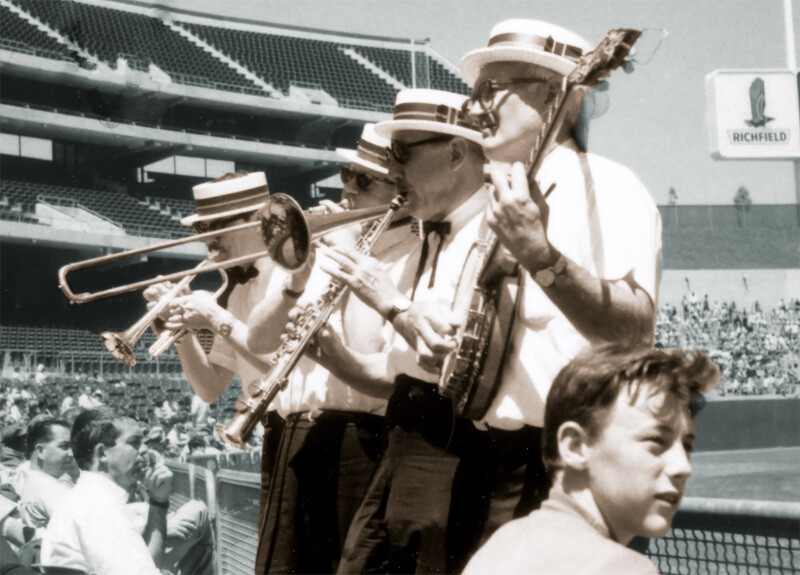
Today you will find Functionalists making a living by supplying music for shopping mall galas, conventions, theme parks, store openings, used car lots, political rallies, retirement homes, etc. They stroll around jazz brunches or jam in a corner at tavern happy hours. In fact, it turns out that, due to their efforts, Dixieland jazz is all over the place these days, being exposed to every segment of our population.
There are a number of major differences between the two communities. Let me briefly outline some of them.
Audience. The largest number of Art Formers are fans. For example, the majority of the Dixieland record community are the record buyers and collectors, not the relatively small number of musicians, engineers and producers. Many more people read The American Rag and other Dixieland periodicals than are involved in their production. Usually (though unfortunately not always) more people attend jazz concerts and festivals than are behind the scenes or on stage.
By contrast, the Functionalists have no organized audience whatsoever. Nobody goes to a used car lot or a department store to hear the Dixielanders who have been hired to play there. Indeed, their presence is hardly ever advertised in advance. When an ad does mention music, it may not say what kind and rarely will state who’s playing.
The Functionalist audience consists entirely of casual passers-by, some of whom may stay and listen for a number or two before moving along. For many Functionalist gigs, the band could probably do quite well with a total repertoire of five tunes because virtually no one hangs around for more than three.
Once in a while a listener may make a request or ask Functional musicians if they have recordings. The requests are honored (Functionalists are there exclusively to please the people), but the Functional combos usually don’t have recordings because the investment required to produce them is too high vs. the virtually negligible opportunity for sales at Functional gigs.
By contrast, Art Form musicians often try to avoid playing requests, preferring to work from a pre-set program that conforms to their own objectives. Some Art Form musicians make more money from sales of recordings at gigs than the fees they receive.
Instrumentation and rehearsal. Functional combos are typically duos, trios or quartets because (1) the employer is trying to keep costs down and (2) the musician is trying to get the gig, so he prices for the smallest number of people that will provide the sound the client wants. Art Form Dixieland bands are usually six or seven pieces because the musicians are playing mostly to please themselves, typically following the paths blazed on their favorite Dixieland recordings.
Functional combos do not rehearse, although as specific musicians work together from time to time they may develop a few head arrangements to use when they’re all on the same job. Functionalists are too busy trying to make a living to indulge the luxury of rehearsals. Many would just as soon relax in a non-musical environment in their off-hours anyway.
Some Art Form bands rehearse on a regular schedule. The rest rehearse at least occasionally to add tunes to the book, work on special material or sharpen up for an important gig.
Presentation. Typically, Functionalists do not put on a show in the sense that Art Formers do at jazz societies, concerts and festivals. Functionalists do not announce tunes and frequently do not sing vocals.
Functional bands will most commonly be found wearing striped shirts, straw hats or other attire that helps stamp them immediately in the public’s mind as Dixielanders. Playing to people who happen upon them unawares, Functionalists need all the visual help they can get to establish their genre right away. On the other hand, many Art Form musicians, for reasons that make no sense to me (see “Texas Shout” for December 1995), would slit their wrists before donning a striped vest or straw hat.
Employers. Art Formers are employed by nightspots (though this scene has all but disappeared at this writing), private functions, jazz societies and festivals. They often get the work via demand pull, i.e., the belief that there is an audience that particularly wants to see a given Art Form combo or artist. Certain bands even have fan clubs which may provide a virtually guaranteed minimum attendance.
Sometimes Art Form employers cooperate to try to facilitate the hiring of Dixielanders. For example, there is a federation of Dixieland jazz clubs in which information is exchanged and there is another of Dixieland festival producers. [Author’s note: since this column first appeared, these two organizations have merged.]
Almost all work for Functionalists comes via musicians who hustle their own jobs – make phone calls, visit potential clients to drop off promotional materials, etc. Because they have no organized audience, there is no demand pull.
Moreover, there is no organized network of Functionalist employers. I doubt that Sears calls Strawbridge’s to see which Dixieland bands Strawbridge’s hired last week. Instead, Sears’ booking agent relies on his/her own personal file of contacts (which may include other stores or sources within the Sears chain).
Economics. Functional jobs pay much better than Art Form jobs as a rule. A Functionalist may play a couple of hours in a department store aisle for about double what an Art Former will get for a 9-to-1 date at a local nightclub.
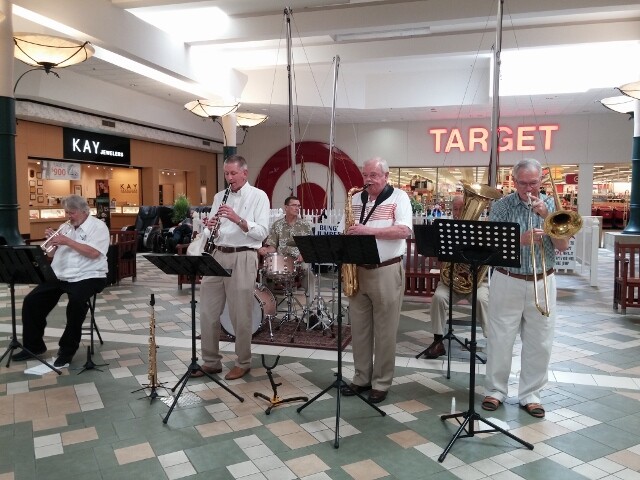
Further, because most Art Form musicians are hobbyists, or at least do not rely on Dixieland jazz for their principal income, some Art Form combos will take nightclub jobs for the gate, for drinks or for next to nothing in pay. Functionalists cannot afford to sell themselves so cheaply.
One rarely sees Functional musicians at festivals for this reason. A Functional Dixielander may be able to get two gigs a day on weekends, each of which pays more than he/she would get as a typical festival sideman for the same day.
(As an aside, West Coast-based Functionalists are more likely to appear at festivals due to the comparatively high proportion of festivals there. The musician may be able to play a Functional gig early in the day and still make a nearby festival.)
Economics are important in the Art Form world because the music is the principal attraction and is thus supposed to pay its way on some level. Yes, some festivals get corporate sponsors to pick up part of the tab. Similarly, some jazz societies offer patron memberships for much the same reason or throw annual multi-band picnics to subsidize periodic concerts that lose money. Nevertheless, if the overall Art Form operation doesn’t finish in the black over the long haul, whether is it is a festival, concert series, Dixieland society or record label, it is probably going to close once the novelty wears off among the backers who are propping it up.
Functionalists don’t have that problem. Their pay comes out of an advertising or promotional budget. Nobody expects them per se to bring anyone in the door.
Economics is also behind the Functionalists’ practice of hiring each other. If Clarinetist A books a gig, the first sideman he hires is Banjoist B, and vice versa. Thus, each has to hustle only half as much to find full-time work for both. This is an eminently sensible procedure, although it does operate as an additional factor that keeps the Functional community from interacting with the Art Form world.
These are some of the principal differences between Functionalists and Art Formers. While you’re pondering them, let me offer a few general observations.
First, Art Formers commonly look down their noses artistically at Functionalists. They believe that Functionalists are playing commercial shallow music that has no lasting merit.
I suppose some of them are, just as are many Art Form musicians (as any seasoned Dixieland listener knows). However, most of the people I know who’ve chosen to play Dixieland, whether Functional or Art Form, do so because they love the music and want to play it as well as they can.
For that reason, performing Functionalist gigs can be quite liberating. Because there is no organized audience, and no show apart from the music is required, Functionalists can play whatever they choose.
I’ve been on a few Functionalist engagements recently and had a ball. The other players were all veteran Dixielanders who love the music. We did whatever tunes we pleased, performing for ourselves as much as for the passers-by, and thoroughly enjoyed the gigs.
Indeed, on one of those, in a department store menswear section, we had a quartet (cornet/piano, trombone, banjo, tuba) which, if I do say so myself, performed at a level comparable to that of many second-tier festival bands I’ve seen. It would, I’m sure, have been warmly received by a typical festival or jazz club audience. The gig may be commercial, but that doesn’t mean the music is also.
Second, Functionalists, because they are often trying to capture an impromptu audience with familiar material, are probably doing more than the Art Formers to keep alive the standard repertoire – those well-known good old good ones that put Dixieland in the public’s eye in the first place. Conversely, we can all name Art Form musicians who would rather have their fingernails torn out than render, for example, a straight-ahead evergreen like “(Back Home In) Indiana.”
Third, Art Formers are constantly saying that our music needs exposure to younger people. Believe me, it gets plenty. There are more teenagers, young adults, thirty- and forty-somethings wandering past Dixieland combos in malls, theme parks and the like in nearly any week than hear Art Formers play in a year.
However, our music means nothing to them. The people who usually stop to listen to a few songs by Functionalists are the elderly (the same age group that forms the bulk of the present-day Art Form audience) and parents with toddlers or infants (who will also stop at the magician or the clown because they want their children to experience everything). The teenagers, young adults and other folks under 50 just keep right on moving along.
This fact reinforces my belief, mentioned several times previously in this column, that the dedicated efforts currently under way by the Art Form community to enlist younger devotees – school concerts, jazz instruction camps, youth bands, etc. – are not going to succeed to the degree necessary to sustain the commercial viability of Art Form Dixieland. The Art Form audience, currently already too small to keep our music alive in some societies and cities, will keep on aging and dying out.
By contrast, though the body of Functional Dixielanders is weighted heavily by mature musicians, there are younger players, struggling to make a living out of music and seeking any paying gig, who book Functional Dixieland jobs. Some of these neophytes, not being familiar with the repertoire or style, are having a tough time getting a foothold, but as long as the gigs are there, Functional musicians of all ages will be doing whatever is necessary to get hired for them.
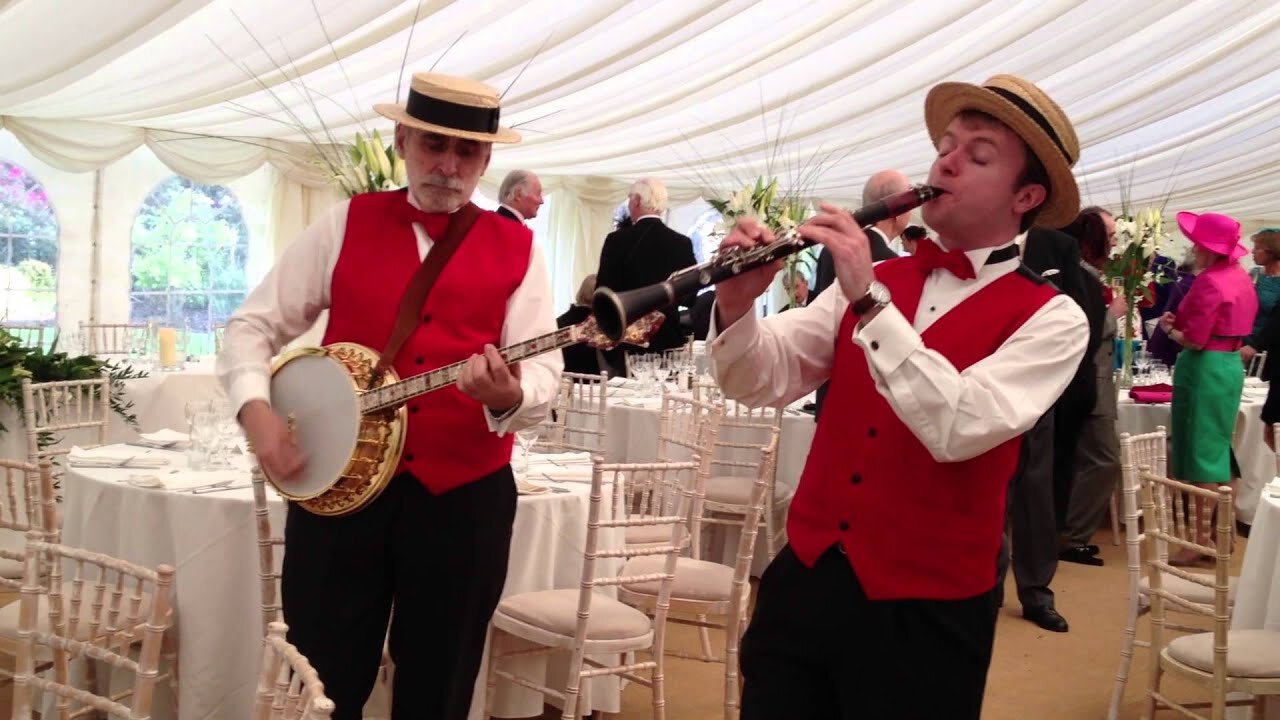
Fourth, the Functional Dixieland community is much healthier than the Art Form community. I recognize that playing Dixieland for a living has always been something of a struggle, but a surprising number of Functionalist musicians are doing it.
On the other hand, you can almost count on your fingers and toes the number of Art Form Dixielanders who are able to make Dixieland support them without supplementing it by teaching music, by non-musical work or by playing swing or other non-Dixieland musics. Anyone who doesn’t realize that the Art Form community is disappearing at an increasing rate is simply in major denial. One jazz society after another now hangs on by its fingernails, former all-Dixieland festivals book ever more non-Dixieland acts to stay solvent, etc.
Functional Dixieland is healthier because, as Dan Zeilinger said in his above-mentioned article, the Dixieland idiom will never die on the Functionalist side. When people want music at their events that is outgoing, uplifting, breezy and cheerful, a combo in striped vests with a banjo and/or tuba is pretty much at the top of the call list. Dixieland still has the ability, even to a crowd that never hears it otherwise and doesn’t care about it in the least, to bring the same good spirits to its listeners that it did when it was being developed in the Crescent City 100 years ago.
Thus, even if every Dixieland jazz club and festival, every Art Form combo and its fans, every Dixieland periodical and every Dixieland recording vanished from the face of the earth tomorrow, the Functional Dixielanders would probably be essentially unaffected. So, if your local Dixieland band loses its gig, or your local society or festival folds, and you need a Dixieland fix, keep an eye on what’s happening at hardware stores around town. You might be pleasantly surprised at what you’ll find.
I want to thank the following three fine musicians, each of whom is much more experienced than I with the Functionalist world, for reading this column in draft form with an eye toward minimizing its errors and omissions: tubaist Norm Burbank of northern New Jersey; banjoist Eliot Kenin of the San Francisco Bay area; and trombonist Matt Zimnoch of Phoenixville, PA. Of course, any such errors and omissions, as well as all other deficiencies in the foregoing text, are my sole responsibility.
* * * *
P.S. to the foregoing reprint: Art Formers have always been the smaller portion of the overall Dixieland audience. The majority of the folks who attend Dixieland weekends are there to spend some time dancing, partying, drinking and generally socializing with their favorite music in the air, not sitting quietly and listening to it throughout.
I hasten to add that there is nothing wrong with doing so. I have said repeatedly in these pages that entertainment for its own sake is a perfectly legitimate reason for attending Dixieland functions. Without the Functional audience, bless its heart, we’d have had a lot fewer Dixieland weekends over the years.
However, as the total audience for Dixieland events has dwindled, the smaller Art Form portion of it has now decreased nearly to the point of nonexistence. That is, Art Form Dixieland is not simply dying; it’s dead.
If you question that statement, ask yourself what new Art Form bands have become hot on the festival circuit during the last twenty years? I here use “hot” in the sense that they are on the first-call lists of festival producers, draw lines waiting to get into their venues, and seem to appear all the time at Dixieland weekends. None come readily to my mind.
The last big wave of such bands came along around 1980, give or take a few years. In those days, we saw the birth of, e.g., The Buck Creek Jazz Band, The Grand Dominion Jazz Band, Professor Plum’s Jazz, The Rent Party Revellers, The Hot Cotton Jazz Band and The Garden Avenue Seven. While some of these combos were “showier” than others, they all played Dixieland jazz extremely well and attracted significant numbers of Art Formers to their programs.
By contrast, the combo sporting a Dixieland instrumentation that I see as the most popular one on the circuit today, one that always plays to packed houses and seems to be working at a special weekend every Friday, is – despite its roster of top-drawer musicians and its ability to play first-rate Dixieland – essentially an act of broad low comedy with occasional musical interludes.
When the Revellers shared the bill with this group a few years back, one of our sidemen went to see it, returning shortly to report that he left the room after the first ten minutes, during which the combo had not yet played a note. Instead, he told us, one sideman was rolling on the floor and another was lurching about the stage pretending to be drunk, while the capacity audience was eating it up, not caring if any music was to be played as long as the humor continued to come thick and fast.
In fact, the current festival scene for Dixieland was pretty well summed up in the February 2003 issue of “The Lowdown” (the newsletter of Seattle’s Uptown Lowdown Jazz Band). Reporting on a weekend recently played by ULJB, its pianist Rose Marie Barr said “We heard that one woman shouted from the audience during one band’s set ‘We didn’t come here just to watch you play – we want entertainment’.”
Think about that statement for a minute. When you and I were first becoming interested in Dixieland, seeing the musicians play WAS the entertainment. We attended shows by Turk Murphy, Wild Bill Davison, Louis Armstrong, Eddie Condon and the others “just to watch them play.” We wanted to see them do in person the things we’d heard on their recordings, not see them lie underneath the piano, arrange the band into tableaus while playing, tap-dance, or engage in any of the other high-jinks that are so commonplace at festivals these days.
Yes, Art Form Dixieland is dead. But the good news is that Functional Dixieland is doing quite well. Take my local stomping grounds, the Delaware Valley, for example.
There is a Philadelphia-based Dixieland combo that claims to play 100 gigs a year and which has been around for a quarter century. Another more recently-formed one boasts of 150 gigs a year.
However, they rarely intersect with the Art Form world. Although I have led for 40 years The Red Lion Jazz Band, a revivalist combo that is well-known to local Art Formers, I have never crossed paths even once with the 100-gig band mentioned above. I am more familiar with the 150-gig band, The Barbone Street Jazz Band, only because it is led by Steve Barbone, who is also the clarinetist with the Red Lions. If I didn’t see Steve each week and thereby stay current on his schedule, I would not ordinarily become aware of most of the gigs at which Barbone Street performs.
For that matter, a few years ago, when I was getting a lot of calls from a Functional Dixielander temporarily located in this area, I met, at his shows, quite a few highly talented Functional musicians who seem to be surviving by playing Dixieland. During my decades as a Dixielander in this area, I had never previously heard of most of them and, although I may just be the local Dixielander with the widest national reputation, most of them had never heard of me either.
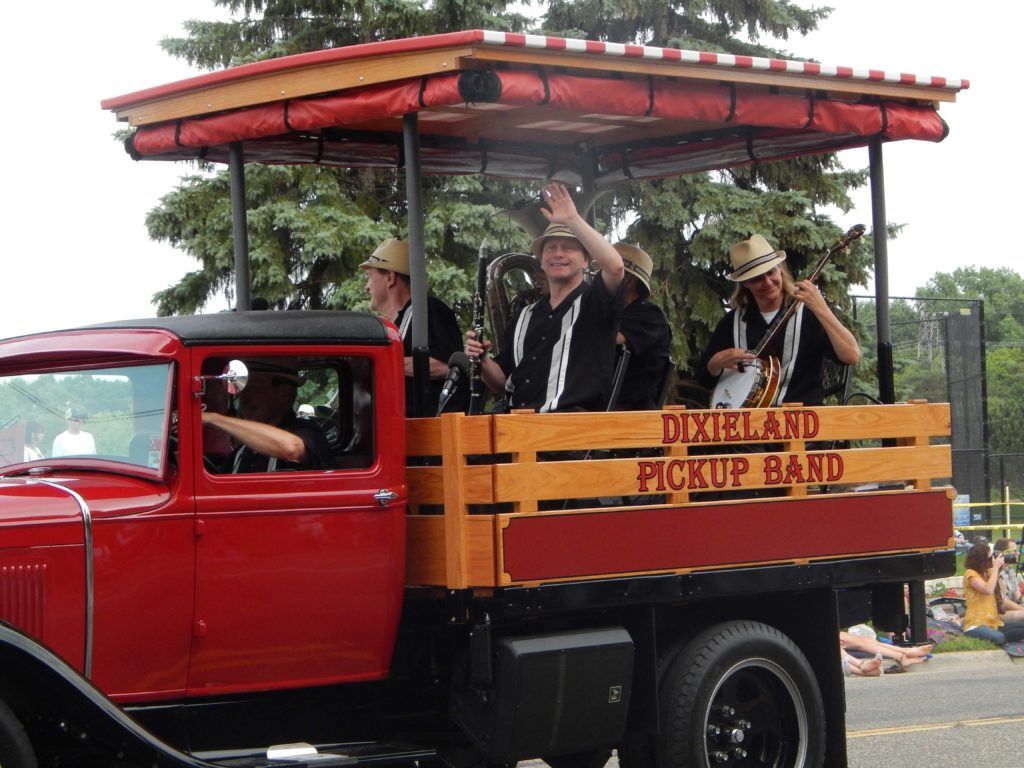
The moral is that there is probably plenty of Dixieland being played around your vicinity, but you won’t find out about much of it through the channels you’ve used in the past. You need to follow up any lead you find to local Functional musicians, stay in touch with them, and go to their gigs if you want to continue to hear the music live.
When you do, be warned. Most of the other folks in the audience will be having a great time, but they have no commitment to the music, have no interest in developing one, will not show up at concerts by your nearest Dixieland society, and may not even be paying much attention to the band at all.
However, they are the ones, going forward, who will be keeping the music alive and available for you to enjoy. Make the most of the opportunity.
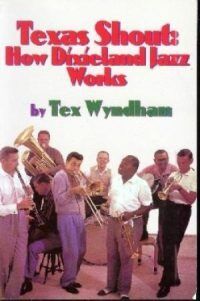 Want to read ahead? Buy the book!
Want to read ahead? Buy the book!
The full run of “Texas Shout” has been collected into a lavishly illustrated trade paperback entitled Texas Shout: How Dixieland Jazz Works. This book is available @ $20.00 plus $2.95 shipping from Tex Wyndham, On request, Tex will autograph the book and add a personalized note (be sure to tell him to whom the note should be addressed).
Tex Wyndham’s 3 CD Guide to Dixieland with music and commentary is available for $20 plus $2.95 shipping. The separate CD, A History of Ragtime: Tex Wyndham Live At Santa Rosa, is available for $13.00 plus $2.00 shipping. On request, Tex will autograph the inner sleeve and add a personalized note (be sure to tell him to whom the note should be addressed).
Send payment to Tex Wyndham, P.O. Box 831, Mendenhall, PA 19357, Phone (610) 388-6330.
Note: All links, pictures, videos or graphics accompanying the Shouts were added at the discretion of the Syncopated Times editorial staff. They did not accompany the original columns and do not necessarily reflect the opinion of Tex Wyndham.
From roughly 1970-2010, Tex Wyndham was: (1) one of the best-known revivalist Dixieland jazz musicians in the US, as cornetist, pianist and bandleader, (2) one of the best-known ragtime pianists in the US, and (3) one of the most respected critics in the US of Dixieland jazz, ragtime, and related music. He is the only person about whom all three of those statements can be made.

